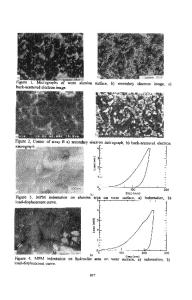Evaluation of the Mechanical Properties of Combined Metal-Oxide-Ceramic Layers on Aluminum Alloys
- PDF / 999,921 Bytes
- 6 Pages / 594 x 792 pts Page_size
- 32 Downloads / 325 Views
EVALUATION OF THE MECHANICAL PROPERTIES OF COMBINED METAL-OXIDE-CERAMIC LAYERS ON ALUMINUM ALLOYS М. М. Student,1,2 V. V. Shmyrko,1 М. D. Klapkiv,1 І. M. Lyasota,1 and L. N. Dobrovol’ska3 We study the physicomechanical properties of metal-oxide-ceramic layers on aluminum alloys and arcsprayed aluminum coatings by the indentation, sclerometry, and combined electrochemical and acousticemission methods. By using these methods, we establish the positive influence of copper on the physicomechanical properties of oxide-ceramic layers. It is shown that, in the presence of copper in the oxide-ceramic layer, its modulus of elasticity, microhardness, and microplasticity increase. Keywords: arc-spraying process, plasma-electrolytic oxidation, oxide-ceramic layers, indentation.
As one of the contemporary technologies used for the protection of aluminum alloys, one can mention the technology of formation of oxide-ceramic layers by the method of plasma-electrolytic oxidation (PEO) [1]. In order to recover the geometric parameters of the worn surfaces of workpieces made of light alloys and improve the wear and corrosion resistance of new products, it is customary to use the procedure of spraying of gasthermal coatings of aluminum alloys with subsequent formation of metal-oxide-ceramic layers by the PEO method [2]. The oxide-ceramic layers have high microhardness. However, they are also characterized by high brittleness. On various aluminum alloys and gas-thermal coatings of these alloys, we observe the formation of oxide layers with different structures and mechanical properties. In many cases, they determine the operating characteristics of products with oxide-ceramic layers. The aim of the present work is to choose a procedure for the evaluation of the mechanical properties of combined metal-oxide-ceramic layers. Materials and Methods of Investigation Composite metal-oxide-ceramic layers were synthesized on AD1, AMg-6, and D16 aluminum alloys and on the arc-sprayed coatings (ASC) of similar chemical compositions formed by spraying from AD1, AMg-6, and D16 electrode wires. The size of particles of the sprayed metal is ≤ 50 µm and the velocity of their flight is ≈ 100 m/sec. The modes of formation of the ASC are as follows: an arc voltage U = 30–32 V, an arc current I = 100– 120 А, and a pressure of the air jet p = 0.6 МРа. The oxide-ceramic layers on aluminum alloys and the ASC of these alloys are obtained by the PEO method in an aqueous electrolyte with the following composition: 3 g/liter KOH + 2 g/liter Na 2SiO 3 for a density of
cathodic and anodic currents of 2 kA/m 2 . 1 2 3
Karpenko Physicomechanical Institute, Ukrainian National Academy of Sciences, Lviv, Ukraine. Corresponding author; e-mail: [email protected].
Lutsk National Technical University, Lutsk, Ukraine.
Translated from Fizyko-Khimichna Mekhanika Materialiv, Vol. 50, No. 2, pp. 116–121, March–April, 2014. Original article submitted December 3, 2013. 290
1068-820X/14/5002–0290
© 2014
Springer Science+Business Media New York
EVALUATION OF THE MECHANICAL
Data Loading...











